The Wait Is Over! Stunning Flyby Images of Pluto Unveiled Today
by Sophia Nasr, @Pharaoness
The wait is over! NASA has just released those first stunning images from Pluto we have all been waiting for. They reveal icy mountains on Pluto rising 3,500 meters (11,000 feet) high, a youthful terrain on Charon with a swath of cliffs and troughs stretching 1000 kilometers (600 miles) and a canyon 7 to 9 kilometers (4 to 6 miles) deep, and other surprising finds that indicate both these worlds have been active recently. In a moving tribute, the feature informally known as the "heart" is now nicknamed 'Tombaugh Regio' in honor of the discoverer of Pluto, Clyde Tombaugh.
Pluto: A Mountainous Terrain with Active Geology
NASA has the world in awe with the first high-resolution image of Pluto's surface. And WOW, what a wonderful and puzzling surface it is. This is our first close look at Pluto – that's right, Pluto! This world was a mere blur just a few days ago, and now we have began to unravel its mysteries.
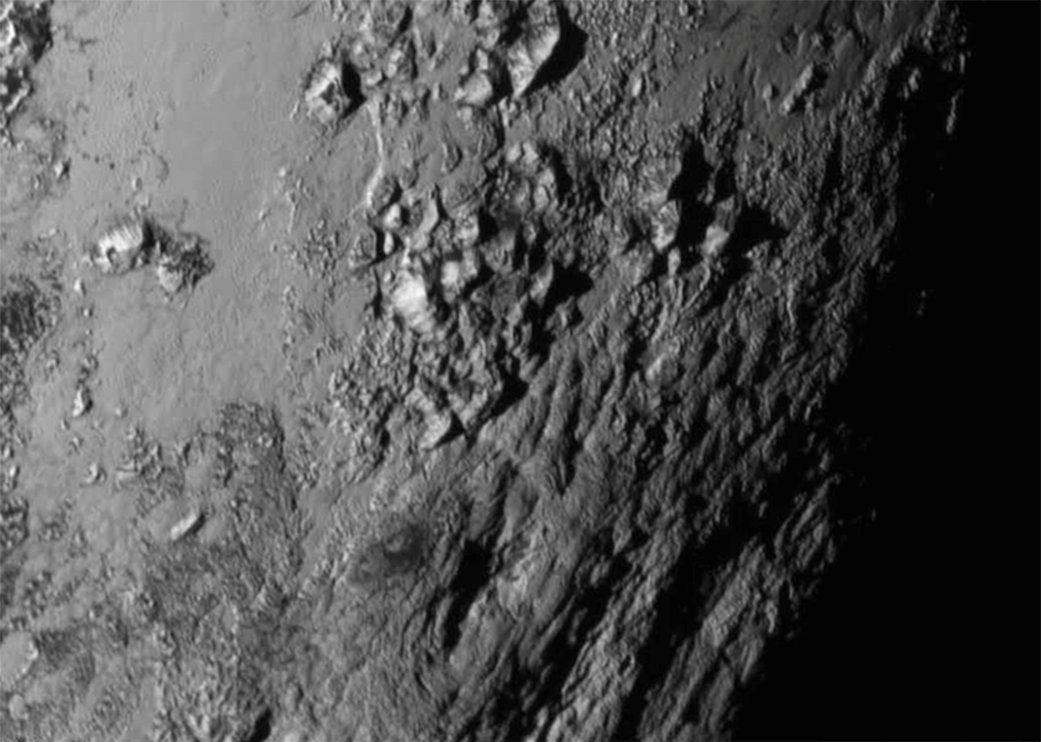

The image covers a region just to the lower left of the heart, now nicknamed the “Tombaugh Regio”. It was taken about 1.5 hours before Pluto's closest approach, when New Horizons was some 77,000 kilometers (47,800 miles) from the surface of the dwarf planet. It has a resolution of less than 1.6 kilometers (1 mile) across.

The image reveals a mountainous terrain on an icy surface, with young mountains 3,500 meters (11,000 feet) high. Young because these mountains are likely no more than 100 million years old (in a solar system that's 4.56 billion years old, these are very youthful), and probably continue to form, says Geology, Geophysics and Imaging (GGI) team leader Jeff Moore of NASA's Ames Research Center in Moffett Field, California. Yes, you heard that right—Pluto may still be geologically active.
The age was estimated by Moore and his colleagues to be so young due to the lack of craters in this area. Planetary bodies tend to be heavily bombarded with debris and full of craters (such as our Moon), unless there is some active process in its recent history to “erase” these markings.
“This is one of the youngest surfaces we've ever seen in the solar system,” says Moore.
The surface terrains of some moons orbiting the gas giants have young surfaces due to heating from gravitational interactions with the giant planet they orbit. The same process is not possible for Pluto, indicating there must be a different active process that generated these mountains.
“This may cause us to rethink what powers geological activity on many other icy worlds,” says GGI deputy team leader John Spencer of the Southwest Research Institute in Boulder, Colorado.
Pluto's surface is covered in methane and nitrogen ices, but these aren't strong enough to form the mountains observed. Instead, what may have created this mountainous terrain is something stiffer—Pluto's bedrock of water-ice. “At Pluto's temperatures, water-ice behaves more like rock,” said deputy GGI lead Bill McKinnon of Washington University, St. Louis.
“Pluto is a real place, with incredibly complex geology,” says Ellen Stofan, NASA's chief scientist. “It is beautiful and it is strange.”
It is interesting to note that the heart itself has different colors on either side, meaning the two areas are probably made of slightly different materials. Pluto is an object with a fascinatingly varying surface terrain.
Having seen this image, I can safely agree with Emily Lakdawalla who said in her most recent write up of today's press conference that Pluto's surface looks nothing like Triton, as many once thought it might. From a distance, the two have similarities. But take a closer look and the two surfaces become strikingly different, meaning the geological histories of Pluto and Triton are dissimilar.
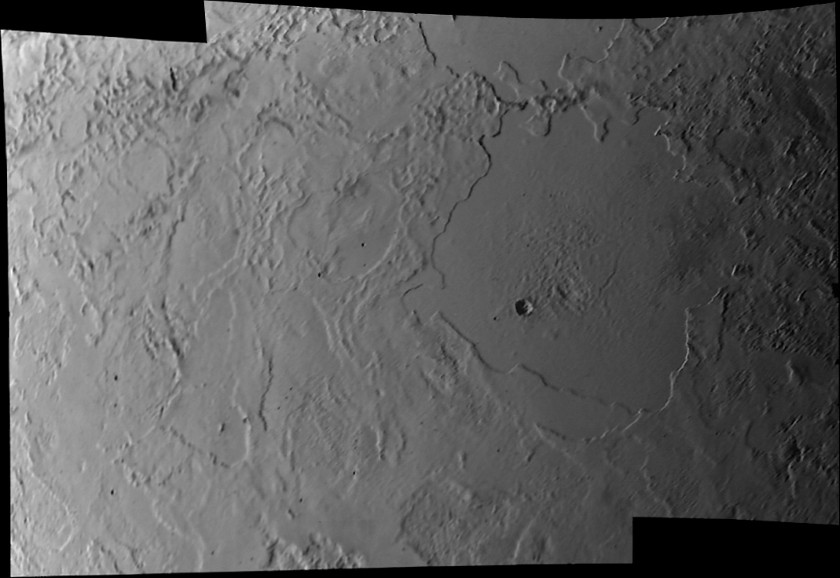
With mountains as high as 3,500 meters (11,000 feet) and possible active geology, Pluto is an object full of surprises. Here's a look at Pluto over the years. It gives me goosebumps, and is nothing short of amazing. This is why we send spacecraft to explore distant worlds.

Methane On Pluto
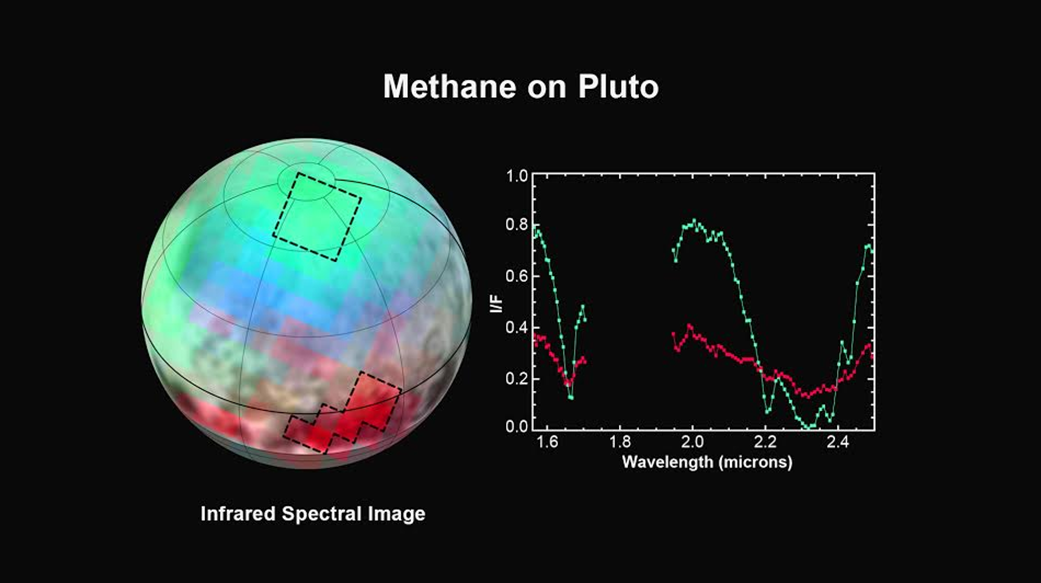
In the spectroscopic data taken by the Linear Etalon Imaging Spectral Array, part of the Ralph instrument, it is apparent that methane ice is all over Pluto, but its amounts vary strikingly from region to region.
“We just learned that in the north polar cap, methane ice is diluted in a thick, transparent slab of nitrogen ice resulting in strong absorption of infrared light,” said New Horizons co-investigator Will Grundy, Lowell Observatory, Flagstaff, Arizona. One of the dark patches along the equator show that the methane ice has shallower absorptions, suggestive of a very different texture in that region. “The spectrum appears as if the ice is less diluted in nitrogen,” Grundy speculated “or that it has a different texture in that area.”
As a comparison for what the different texture means, take an example from Earth. Fluffy white snow has a bright white color, while solid polar ice looks blue in color. The data taken by New Horizons' Ralph instrument will be analyzed to shed light on the compositions of these varying regions on Pluto.
Charon: A Moon with a Youthful and Varied Terrain
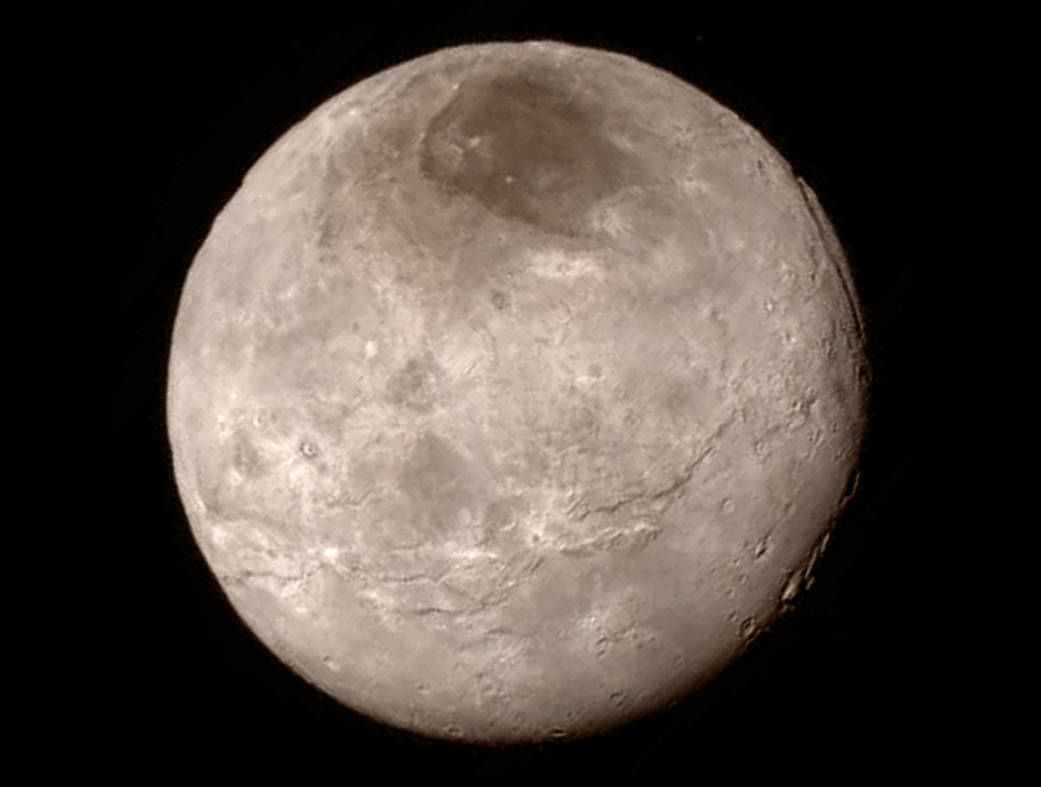
You're looking at the closest ever view of Pluto's largest moon Charon. And look, its dark pole nicknamed “Mordor” (how fitting for us Lord of the Rings fans) has indeed persisted! This one was taken by the LORRI camera late on July 13, 2015 from 466,000 kilometers (289,000 miles) away, and combined with color data from the Ralph instrument. In the higher contrast areas, details as small as 5 kilometers (3 miles) can be resolved. Lower contrast areas may appear smoother than they actually are due to the compression of the image file. The uncompressed version will be transmitted to Earth on a later date.
Cliffs and troughs stretch over 1000 kilometers (600 miles) on Charon's surface. These are suggestive of large scale fracturing on its crust, and probably are due to internal processes. If you look to the upper right along Charon's edge, you'll see a long canyon, or a crack, estimated to be about 7 to 9 kilometers (4 to 6 miles) deep.
What is rather surprising is that Charon doesn't have much cratering on its surface. Even at the lower edge, where the Sun's rays hit it on an angle and make shadows easily visible, there are very few craters visible. This suggests that some geological activity has erased craters, or renewed its surface. "Charon has been active [recently], and there are mountains in the Kuiper belt," said Alan Stern, Principal Investigator of New Horizons, during today's press conference.
The dark pole “Mordor” on Charon now has a distinct boundary, and is likely formed of dark material deposits. These materials may be ices that were changed by cosmic radiation, causing the cap to darken. "We think that the dark coloring could perhaps be a thin veneer," said Olkin. This makes sense, as the craters on the dark cap are bright, meaning the material beneath the dark layer is whitish like the rest of the moon. Underlying the dark pole is a clear and sharply bounded angular feature. This feature is expected to be revealed once higher resolution images arrive.
It is now strikingly clear how different Pluto and its moon Charon are from each other. “Pluto and Charon look very different,” Stern said. “Now we can see how dramatically different they really are.”
Hydra: a Pixelated Wonder
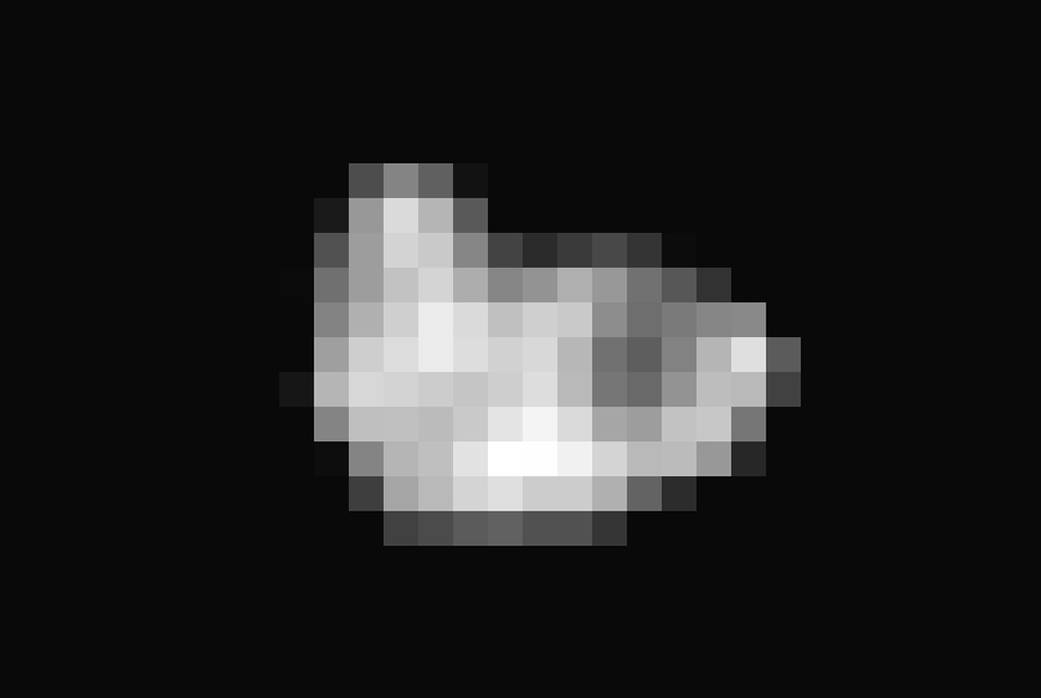
While the Pluto and Charon images were the real showstoppers of the day, we also got the best ever look at Hydra, one of Pluto's smaller moons. "Pluto and Charon are going to steal the day today, but let's not forget that Pluto has four small moons," said Hal Weaver, project scientist for New Horizons, during today's press conference.
Pixelated as it may be, this is our first true look at what Hydra, Pluto's outermost moon, looks like. Discovered in 2005, this moon has been shrouded in uncertainty in terms of its shape, size, and reflectivity. After New Horizons' historic flyby, this image of Hydra, taken some 644,000 kilometers (400,000 miles) from the moon, is resolved enough to determine all these properties. The image has a resolution of 3 kilometers (2 miles) per pixel, revealing a potato-like body some 43 kilometers (27 miles) by 33 kilometers (20 miles) with striking variations in brightness. Looks pretty similar in shape to Comet 67P/Churyumov-Gerasimenko, if you ask me.
Hydra is likely covered in water ice, much like Charon. The dark region you see in the image is about 10 kilometers (6 miles) across. Hydra's reflectivity is somewhere between that of Pluto and Charon, reflecting about 45% of the sunlight that hits its surface. "New Horizons has finally nailed the basic physical properties of Hydra," says Hal Weaver, New Horizons Project Scientist and LORRI science operations lead. "We're going to see Hydra even better in the images yet to come."
New Horizons has traveled for over 9 years and about 4.8 billion kilometers (3 billion miles) to reach Pluto. We have waited, anxiously, for all these views of the Pluto system. We have only received a small portion of the data stored on New Horizons' memory banks – in fact; we are yet to see the highest resolution images. And yet, these images are already challenging the workings of small, icy worlds like Pluto. Just when we've begun to unwrap some of its mysteries, Pluto has presented us with a few more intriguing ones to decipher. This is what it means to be at the forefront of planetary exploration and scientific discovery.
For the original Pluto press release, click here.
For the original Charon press release, click here.
For the original Methane press release, click here.
For the original Hydra press release, click here.
 Sophia Nasr is an astrophysics student at York University. Actively involved in the astronomical community at York U, she is the President of the Astronomy Club at York University and a member of the team at the York University Observatory. She also is involved in university projects, and holds a position in research on dark matter at York U. Holding scientific outreach dear, Sophia is actively involved in social media outlets such as Facebook, Twitter, and Google Plus, where she shares with the world her passion for the universe and how it works.
Sophia Nasr is an astrophysics student at York University. Actively involved in the astronomical community at York U, she is the President of the Astronomy Club at York University and a member of the team at the York University Observatory. She also is involved in university projects, and holds a position in research on dark matter at York U. Holding scientific outreach dear, Sophia is actively involved in social media outlets such as Facebook, Twitter, and Google Plus, where she shares with the world her passion for the universe and how it works.







